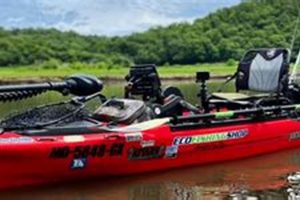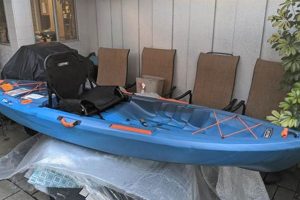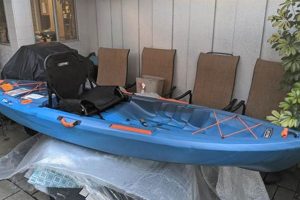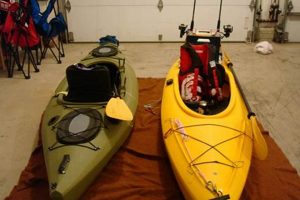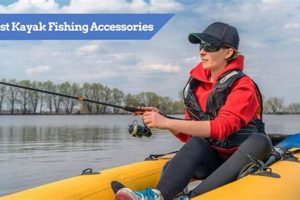Enhancements designed for fishing kayaks range from basic necessities for safety and functionality to cutting-edge technologies that improve angling success and overall experience. Examples include rod holders, fish finders, anchor systems, and specialized storage solutions. These additions transform a standard kayak into a dedicated fishing platform.
A well-equipped fishing kayak offers significant advantages. Improved organization and readily accessible gear streamline the fishing process, allowing anglers to focus on the sport. Enhanced stability and safety features contribute to a more secure and enjoyable experience on the water. Furthermore, technological advancements in fish finding and navigation equipment can significantly increase the likelihood of a successful catch. Historically, kayak fishing relied on simpler tools and techniques, but modern innovations have dramatically elevated the sport’s potential.
This article will explore various categories of enhancements, examining the diverse options available to kayak anglers and highlighting the key features to consider when selecting the right gear for individual needs and fishing styles. It will delve into specific product recommendations and offer practical advice on installation and usage.
Tips for Equipping a Fishing Kayak
Careful selection of kayak fishing enhancements is essential for a successful and enjoyable experience. These tips offer guidance on choosing appropriate gear.
Tip 1: Prioritize Stability: Begin by assessing stability needs. Wider kayaks and outriggers offer increased stability, crucial for anglers standing to cast or reel in larger fish. Consider the typical fishing environment and choose enhancements that complement the kayak’s stability characteristics.
Tip 2: Streamline Gear Storage: Efficient storage solutions are paramount. Tackle boxes, dry bags, and specialized compartments keep gear organized and protected from the elements. Prioritize readily accessible storage for frequently used items.
Tip 3: Invest in a Quality Anchor System: A reliable anchor system is essential for maintaining position in currents or wind. Consider anchor trolleys for precise positioning and quick adjustments. Choose an anchor appropriate for the typical bottom conditions.
Tip 4: Select Appropriate Rod Holders: Rod holders should secure rods effectively while allowing easy access. Consider adjustable rod holders for varied fishing techniques and choose materials resistant to corrosion in saltwater environments.
Tip 5: Enhance Visibility with Lighting: Adequate lighting is critical for safety, especially during low-light conditions. Navigation lights and deck lights improve visibility to other boaters. Consider adding lighting to tackle boxes and storage areas for easier access in the dark.
Tip 6: Utilize Technology Strategically: Fish finders and GPS units provide valuable information about fish location and water depth. Choose models with features suitable for the target species and fishing environment. Integrate these technologies seamlessly with other kayak accessories.
Tip 7: Consider Comfort and Ergonomics: Comfortable seating and adjustable footrests enhance long-term comfort, allowing for extended fishing sessions. Choose seating materials that are durable and resistant to moisture and UV exposure.
By carefully considering these factors, anglers can create a personalized and efficient fishing kayak setup, maximizing both enjoyment and success on the water.
This information provides a solid foundation for equipping a fishing kayak. The following section will offer specific product recommendations tailored to different fishing styles and budgets.
1. Rod Holders
Rod holders represent a critical component within the broader category of fishing kayak accessories. Their primary function, securing fishing rods, directly impacts angling efficiency and safety. Without secure rod storage, anglers face challenges in managing multiple rods, paddling, and landing fish. This can lead to tangled lines, lost rods, and potentially dangerous situations. Dedicated rod holders free an angler’s hands for other tasks, increasing responsiveness to bites and improving overall fishing success. For example, trolling multiple lines necessitates secure rod placement to prevent tangling and maintain proper lure presentation. Similarly, when battling a strong fish, secure rod storage allows for better leverage and control, minimizing the risk of equipment loss or capsizing.
Several types of rod holders cater to specific needs and fishing styles. Flush-mount rod holders offer a streamlined profile and are ideal for trolling or drifting. Adjustable rod holders provide flexibility in positioning rods at different angles, accommodating various fishing techniques. Rotating rod holders allow for quick adjustments to changing currents or fish movements. The selection of appropriate rod holders depends on factors such as the type of fishing practiced, the size and number of rods used, and the kayak’s layout. Proper installation and placement are crucial for maximizing their effectiveness and minimizing interference with paddling and other onboard activities.
In summary, rod holders are an essential element of a well-equipped fishing kayak. Their impact extends beyond mere convenience, significantly contributing to angler safety and fishing success. Selecting and installing appropriate rod holders, tailored to individual fishing styles and needs, represents a key step in optimizing kayak fishing performance.
2. Fish Finders
Fish finders represent a pivotal technological advancement within the realm of fishing kayak accessories. Their integration bridges the gap between traditional angling techniques and modern data-driven approaches. By providing real-time information about water depth, bottom structure, and fish location, these devices significantly enhance the angler’s ability to locate and target fish. This transforms the fishing experience from a passive search into an active pursuit, increasing the likelihood of a successful catch. For instance, an angler seeking specific bottom structures favored by a target species can utilize a fish finder to identify these areas, increasing the chances of encountering the desired fish. Conversely, without this technology, locating such areas would rely heavily on guesswork and experience, potentially resulting in wasted time and effort.
Technological advancements continue to refine fish finder capabilities. Modern units offer features like GPS integration, side-scanning sonar, and down-imaging, providing detailed underwater mapping and precise fish location. This detailed information empowers anglers to make informed decisions about lure selection, retrieval techniques, and fishing locations. Consider a scenario where an angler identifies a school of fish suspended mid-water. Armed with this knowledge, the angler can select a lure that targets that specific depth and employ a retrieval technique designed to entice those fish. Such strategic approaches, facilitated by fish finder technology, significantly increase fishing efficiency.
The selection and integration of a fish finder represent a critical consideration when outfitting a fishing kayak. Factors such as screen size, transducer type, and power requirements should align with the specific fishing environment and target species. Furthermore, proper installation and mounting are crucial to ensure optimal performance and minimize interference with other onboard equipment. Understanding the capabilities and limitations of fish finder technology is paramount for maximizing its effectiveness and integrating it seamlessly into a comprehensive kayak fishing strategy.
3. Anchor Systems
Anchor systems represent a crucial component within the category of effective fishing kayak accessories. Their function extends beyond simply securing a kayak in a desired location; they directly impact fishing success and overall safety. A stable kayak allows anglers to focus on fishing techniques and respond effectively to bites, rather than constantly battling current or wind drift. This stability becomes particularly critical in scenarios such as fishing in strong currents, targeting specific structures, or battling larger fish. For example, when presenting a bait to a specific submerged log or rock pile, a secure anchor prevents drift and allows precise lure placement, maximizing the chances of attracting fish. Conversely, without a reliable anchor system, maintaining position in these situations becomes challenging, leading to frustration and decreased fishing effectiveness.
Various anchor types cater to different fishing environments and kayak designs. Lightweight folding anchors suit shallow water and smaller kayaks, while heavier grapple anchors provide superior holding power in deeper water or stronger currents. Anchor trolleys further enhance control, allowing anglers to adjust the anchor’s position and the kayak’s angle relative to the current or wind. This adaptability proves invaluable when fishing along shorelines, around structures, or in changing weather conditions. Choosing an appropriate anchor system necessitates considering factors such as water depth, bottom composition, prevailing currents, and kayak size. An improperly sized or deployed anchor can be ineffective or even pose a safety risk.
Effective deployment and retrieval of an anchor system contribute significantly to a smooth and efficient fishing experience. A well-organized anchor setup minimizes tangling and allows for quick adjustments. Furthermore, understanding anchoring techniques specific to kayak fishing, such as deploying the anchor from the bow or stern depending on the situation, maximizes control and stability. In conclusion, a well-chosen and properly utilized anchor system represents a vital element within the broader context of fishing kayak accessories, directly contributing to angler safety, fishing effectiveness, and overall enjoyment on the water.
4. Kayak Crates
Kayak crates represent a crucial intersection of functionality and customization within the realm of cool fishing kayak accessories. They provide a versatile platform for organizing gear, maximizing storage space, and personalizing the kayak fishing experience. Their modularity and adaptability make them a valuable addition for anglers seeking to optimize their on-the-water efficiency and comfort.
- Storage and Organization
Kayak crates offer a practical solution for managing fishing tackle, tools, and other essential gear. Their open design allows for easy access and visibility, while their customizable compartments and dividers facilitate organization tailored to individual preferences. For example, a crate can be configured to hold tackle boxes, pliers, knives, and other frequently used items within easy reach. This eliminates the need to rummage through bags or hatches, streamlining the fishing process and minimizing wasted time.
- Space Optimization
Kayak crates maximize limited deck space by providing vertical storage solutions. They utilize otherwise unused space, keeping essential gear secure and accessible without cluttering the cockpit. Anglers can mount crates behind seats, in front of footwells, or on side rails, depending on the kayak’s layout and the angler’s preferences. This efficient use of space contributes to a more organized and comfortable fishing environment.
- Customization and Modularity
The versatility of kayak crates extends to their adaptability and customization potential. Anglers can modify crates with rod holders, cup holders, fish finder mounts, and other accessories to create a personalized fishing platform. This modularity allows for tailoring the crate to specific fishing styles and needs. An angler specializing in trolling, for instance, might add multiple rod holders to their crate, while a bass angler might prioritize storage for tackle boxes and soft plastics.
- Stability and Safety
Properly secured kayak crates can contribute to overall kayak stability. By distributing weight evenly and preventing gear from shifting during movement, they enhance balance and reduce the risk of capsizing. Securely attaching the crate to the kayak’s deck using straps or hardware ensures that it remains stable even in rough water or during sudden maneuvers. This contributes to a safer and more confident fishing experience.
In summary, kayak crates represent a valuable addition to the arsenal of cool fishing kayak accessories. Their contribution extends beyond mere storage solutions; they enhance organization, optimize space utilization, and provide a platform for customization, ultimately contributing to a more efficient, comfortable, and enjoyable kayak fishing experience. Choosing the right crate, configuring it effectively, and securing it properly are crucial steps in maximizing its benefits and integrating it seamlessly into a comprehensive kayak fishing setup.
5. Paddle Leashes
Paddle leashes represent a seemingly minor yet critically important component within the broader category of cool fishing kayak accessories. Their primary function, securing the paddle to the kayak, prevents loss in the event of a capsize or accidental drop. This seemingly simple function has significant implications for angler safety and the overall kayak fishing experience. Consider a scenario where an angler hooks a large fish, requiring both hands for the rod and reel. Without a paddle leash, a sudden surge from the fish or an unexpected wave could easily dislodge the paddle, leaving the angler stranded without a means of propulsion. In such a situation, a paddle leash ensures the paddle remains readily accessible, mitigating potential danger and allowing the angler to maintain control of the kayak.
The practical significance of a paddle leash extends beyond emergency situations. It provides peace of mind, allowing anglers to focus on fishing rather than constantly worrying about securing their paddle. This becomes particularly relevant in challenging conditions such as strong currents, wind, or rough water. A paddle leash allows for more fluid transitions between paddling and fishing, enhancing overall efficiency and enjoyment. For example, an angler sight-fishing along a shoreline can quickly stow their paddle using the leash and grab their rod when a fish is spotted, minimizing disruption and maximizing responsiveness. Furthermore, the relatively low cost and simple installation of a paddle leash make it a highly practical and valuable addition to any fishing kayak setup.
While various types of paddle leashes exist, their core function remains the same: to provide a secure connection between the paddle and the kayak. Selecting an appropriate leash involves considering factors such as leash length, attachment method, and material durability. A leash that is too short can restrict paddling movement, while a leash that is too long can become tangled or create a tripping hazard. Durable materials resistant to saltwater corrosion and UV degradation are essential for long-term reliability. Ultimately, incorporating a paddle leash into a kayak fishing setup demonstrates a proactive approach to safety and enhances the overall on-the-water experience, allowing anglers to focus on the sport with confidence and peace of mind.
6. Comfortable Seating
Comfortable seating constitutes a critical factor within the broader context of cool fishing kayak accessories, directly impacting angler endurance, focus, and overall enjoyment. Extended periods on the water, often in challenging conditions, necessitate seating that provides adequate support, minimizes fatigue, and allows for freedom of movement. Ignoring seating comfort can lead to discomfort, reduced fishing effectiveness, and potentially even long-term physical issues. A well-designed seating system enhances the overall kayak fishing experience, allowing anglers to remain comfortable and focused on the sport.
- Ergonomics and Support
Ergonomically designed kayak seats prioritize proper posture and spinal alignment, reducing strain and fatigue during long fishing trips. Features such as adjustable backrests, lumbar support, and contoured seating surfaces contribute to optimal comfort and minimize pressure points. An angler experiencing back pain due to poor posture, for example, will find an ergonomic seat significantly improves comfort and allows for longer fishing sessions without discomfort. Conversely, a poorly designed seat can exacerbate existing back problems and lead to premature fatigue.
- Material and Construction
Seat materials and construction significantly influence comfort and durability. Breathable fabrics enhance airflow, preventing overheating and moisture buildup, particularly in warm climates. Durable, UV-resistant materials withstand prolonged exposure to the elements, ensuring long-term performance. Closed-cell foam padding provides cushioning and support while resisting water absorption, maintaining its comfort and buoyancy even when wet. An angler fishing in hot, humid conditions will appreciate the breathability of a mesh seat, while an angler frequently encountering saltwater will benefit from the corrosion resistance of marine-grade materials.
- Adjustability and Customization
Adjustable seating systems allow anglers to customize their position for optimal comfort and fishing effectiveness. Features such as adjustable backrests, seat height adjustments, and sliding tracks cater to individual preferences and body types. An angler who prefers to stand while casting, for example, will benefit from a higher seat position, while an angler who primarily sits will prioritize a lower, more stable position. This adaptability enhances comfort and facilitates various fishing techniques.
- Integration with Kayak Design
Seamless integration of the seating system with the overall kayak design contributes to stability and performance. A secure and stable seat base prevents unwanted movement and enhances balance, particularly during casting or reeling in fish. Compatibility with other kayak accessories, such as rod holders and footrests, further optimizes the fishing experience. An angler fishing in rough water, for instance, will appreciate the stability provided by a well-integrated seating system, minimizing the risk of capsizing or discomfort caused by excessive rocking.
In conclusion, comfortable seating represents a crucial investment within the broader scope of cool fishing kayak accessories. Prioritizing ergonomics, material quality, adjustability, and integration with the kayak design contributes significantly to angler comfort, endurance, and overall fishing enjoyment. A well-chosen seating system enhances the overall kayak fishing experience, enabling anglers to focus on the sport and maximize their time on the water.
Frequently Asked Questions
This section addresses common inquiries regarding enhancements for fishing kayaks, providing concise and informative responses.
Question 1: What are the most essential accessories for a beginner kayak angler?
Essential accessories for beginners include a personal flotation device (PFD), a paddle leash, a basic anchor system, and a rod holder. These foundational items prioritize safety and fundamental functionality.
Question 2: How does one choose the right fish finder for a kayak?
Fish finder selection depends on factors such as target species, fishing environment, and budget. Smaller kayaks benefit from compact units with simpler displays, while anglers targeting specific species in deeper water may require more advanced sonar capabilities.
Question 3: What are the advantages of using a kayak crate for fishing?
Kayak crates enhance organization and storage, keeping essential gear readily accessible. Their modularity allows for customization with rod holders, fish finder mounts, and other accessories, optimizing the kayak’s layout for individual fishing styles.
Question 4: What type of anchor is best suited for kayak fishing?
Anchor selection depends on factors like water depth, bottom composition, and current strength. Folding anchors suit shallow water and calm conditions, while heavier grapple anchors excel in deeper water and stronger currents. Anchor trolleys offer enhanced positioning control.
Question 5: How can one improve the comfort of a fishing kayak seat?
Comfort can be improved with additional padding, adjustable backrests, and lumbar support. Aftermarket seating systems offer enhanced ergonomics and customization options for extended fishing trips.
Question 6: What safety precautions should be taken when using kayak fishing accessories?
Essential safety precautions include always wearing a PFD, carrying a whistle or other signaling device, informing someone of the fishing plan, and checking weather conditions before departure. Ensuring proper installation and secure mounting of all accessories is also crucial for safe operation.
Addressing these common inquiries provides a foundation for informed decision-making when selecting and utilizing accessories for fishing kayaks. Careful consideration of individual needs and fishing styles ensures optimal performance, safety, and enjoyment on the water.
This FAQ section provides a comprehensive overview of common concerns. The following section will offer concluding remarks and summarize key takeaways from the article.
Conclusion
Optimizing a fishing kayak with appropriate enhancements significantly impacts angling success and overall experience. From foundational safety elements like personal flotation devices and paddle leashes to specialized equipment such as fish finders and advanced rod holders, each component plays a crucial role. Strategic selection and proper utilization of these tools enhance efficiency, comfort, and safety on the water, allowing anglers to focus on the pursuit of their target species. Careful consideration of individual fishing styles, target species, and prevailing conditions guides informed decision-making regarding appropriate gear. The integration of technology, ergonomic design, and practical functionality elevates the kayak fishing experience from basic angling to a specialized and rewarding pursuit.
Effective utilization of specialized equipment distinguishes a standard kayak from a dedicated fishing platform. Investing in appropriate gear, understanding its capabilities, and employing it strategically enhances not only fishing success but also safety and enjoyment. Continual advancements in kayak fishing technology promise further refinements and innovations, offering anglers even greater opportunities to optimize their pursuit of the sport.


